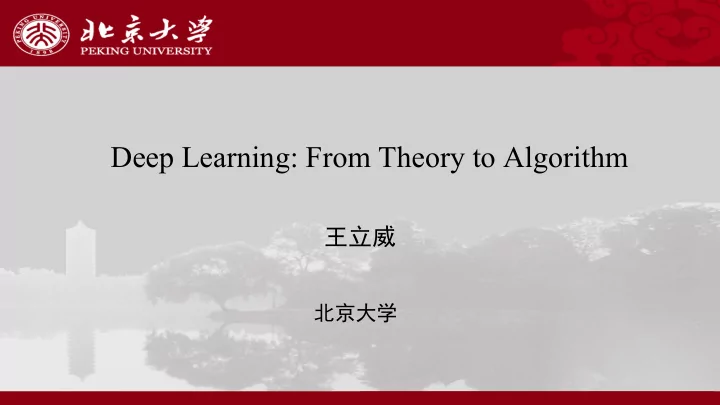

Deep Learning: From Theory to Algorithm 王立威 北京大学
Outline: 1. Overview of theoretical studies of deep learning 2. Optimization theory of deep neural networks 1) Gradient finds global optima 2) Gram-Gauss-Newton Algorithm
Success of Deep Learning Mainly four areas: Computer Vision Speech Recognition Natural Language Processing Deep Reinforcement Learning
Basic Network Structure Fully Connected Network Convolutional Network Further improvement: Residual Network … Recurrent Network (LSTM …)
Mystery of Deep Neural Network For any kind of dataset, DNN achieves 0 training error easily. Why do neural networks work so well? Over- A key factor: Parametrization
Supervised Learning A common approach to learn: ERM (Empirical Risk Minimization)
Theoretical Viewpoints of Deep Learning • Model (Architecture) – CNN for images, RNN for speech… – Shallow (but wide) networks are universal approximator (Cybenko, 1989) – Deep (and thin) ReLU networks are universal approximator (LPWH W , 2017) • Optimization on Training Data – Learning by optimizing the empirical loss, nonconvex optimization • Generalization to Test Data – Generalization theory
Representation Power of DNN Goal: find unknown true function Universal Approximation Theorem NN can approximate any continuous function arbitrarily well: Hypothesis Space (i.e. deep network) 1. Depth bounded (Cybenko, 1989) 2. Width bounded (LPWH W , 2017) Issue: only show existence, ignore the algorithmic part Cybenko, Approximation by superpositions of a sigmodial function, 1989 Lu et al. The Expressive Power of Neural Networks: A View from the Width, NIPS17
Some Observations of Deep Nets # of parameters >> # of data, hence easy to fit data Without regularization, deep nets also have benign generalization For random label or random feature, deep nets converge to 0 training error but without any generalization How to explain these phenomena? ICLR 2017 Best Paper: “Understanding deep learning requires rethinking generalization”
Traditional Learning Theory Fails Common form of generalization bound (in expectation or high probability) Capacity Measurement Complexity VC-dimension Rademacher Average All these measurements are far beyond the number of data points!
Generalization of DL: margin theory Bartlett et al. (NIPS17): Normalize Lipschitz constant (product of spectral Main idea norms of weighted matrices) by margin Final bound Remark: (1) nearly has no dependence on # of parameters (2) a multiclass bound, with no explicit dependence on # of classes
The Generalization Induced by SGD: Train faster generalize better In nonconvex case, there are some results, but very weak Hardt et al. (ICML15) , for SGD:
Our Results From the view of stability theory:
Our Results From the view of PAC-Bayesian theory:
Optimization for Deep Neural Network • Loss functions for DNN is highly non-convex • Common SG methods (such as SGD) work well What‘s the reason behind above facts?
Our Results (DLL W Z, 2019) GD finds global minima in a linear convergence rate!
Our Results (DLL W Z, 2019) Note there is an exponential improvement about the network width compared with fully connected network! Du et al. Gradient Descent Finds Global Minima of Deep Neural Networks, ICML19
Concurrent Results Concurrently, Allen-Zhu et al. [1] and Zou et al. [2] proved (Stochastic) GD converges to global optimum under some similar but a little different assumptions. When width of network is infinite, gradient descent converges to the solution of a kernel regression, which is characterized by Neural Tangent Kernel (NTK) [3]. [1] Allen-Zhu et al. A convergence theory for deep learning via over-parameterization [2] Zou et al. Stochastic gradient descent optimizes over-parameterized deep ReLU networks [3] Jacot and Gabriel, Neural Tangent Kernel: convergence and generalization in neural networks (NIPS18)
Critical Facts 1. There is a global optimum inside this neighbor. 2. Can we design faster algorithm than (stochastic) GD?
Second Order Algorithm for DNN In classic convex optimization, second order algorithm achieves much faster convergence rate. Main idea: use second order information (Hessian matrix) to accelerate training at the price of additional computational cost. Second order algorithm for DNN is much more challenging: 1. Loss function is highly non-convex; 2. High dimensional parameter space (which is usually ignored in classic convex optimization).
Classic Gauss-Newton Method Non-linear least square: Notation: (Jacobian)
Potential Issues 3. Computational complexity may be expansive compared with SGD.
Key Observation
Gram-Gauss-Newton (GGN) Algorithm Mini-batch extension: Stable version:
Computational Complexity Space complexity: Time complexity: Compared with SGD: Nearly the same computational cost, except keeping track of the derivative of every data point in mini-batch, instead of their average in SGD.
Theoretical Guarantee (CGHH W ) 1. Quadratic convergence; 2. Conclusion holds for general networks like GD. Cai et al. A Gram-Gauss-Newton Method Learning Over-Parameterized Deep Neural Networks for Regression Problems, Arxiv19
Experiments RSNA Bone Age task: predicting bone age by images (a) Loss-time curve (b) Loss-epoch curve
Experiments (a) Test performance (b) Training with different hyper-parameters
Take-aways • We prove Gradient Descent achieves global optimum in a linear convergence rate for general over-parametrized neural network. • We propose a novel quasi second order algorithm (GGN) for training network, which converges in quadratic order for general over- parametrized neural network and enjoys nearly the same computational complexity as SGD for regression task.
Related Paper 1. Gradient Descent Finds Global Minima of Deep Neural Networks, ICML19 2. A Gram-Gauss-Newton Method Learning Overparameterized Deep Neural Networks for Regression Problems, Arxiv, 2019 3. Lu et al. The Expressive Power of Neural Networks: A View from the Width, NIPS17
Thank you!
Recommend
More recommend